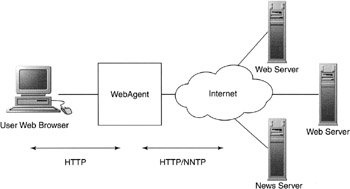Sample Application
Let's now look at a very simple example of an agent that provides a service to a user under the classification of a filtering agent. The purpose of the agent is to communicate with news services on the Internet and to collect information of interest to the user based upon the user's predefined criteria. The filtering agent will then provide the information back to the user in the order most applicable to the user's request (information that scores best based upon the search terms).
WebAgent Design
The WebAgent is constructed using a variety of standard protocols, and utilizes the standard Web browser to report results back to the user. The WebAgent utilizes a HyperText Transfer Protocol (HTTP) server to communicate with a user, an HTTP client to communicate with external servers, and a Network News Transfer Protocol (NNTP) client to communicate with external news sources (see Figure 11.3).

Figure 11.3: High-level architecture for the WebAgent.
The WebAgent will serve as an application that mediates between the user and the Internet for news reading. The user configures the WebAgent through a simple configuration file (to be detailed later). In this configuration file, the user defines Web pages to monitor (report if they change) and newsgroups to monitor for specific search criteria. When news items are found that match a given criteria, the item is saved and delivered to the user through a simple Web page in order of most search terms matched. The user can then click on the link for the particular monitored Web site or news item and be taken directly to that content.
The goal of the agent is to simplify news reading for a user, filtering out content that may not be of interest and presenting first what should be of most interest to the user.
WebAgent Characteristics
The WebAgent represents a very simple agent and includes no learning ability. Its characteristics include autonomy (it works in the background without user direction) and its communicative ability with external servers for data collection.
The WebAgent's sensors are the standard application layer protocols that allow it to gather the information that it needs for its user based upon predefined search criteria. The HTTP Web protocol is also used to communicate results back to the user. The user then connects to the WebAgent just as it would any other Web server.
| On the CD | The source code for the WebAgent application can be found on the CD-ROM at ./software/ch11. |
EAN: 2147483647
Pages: 175